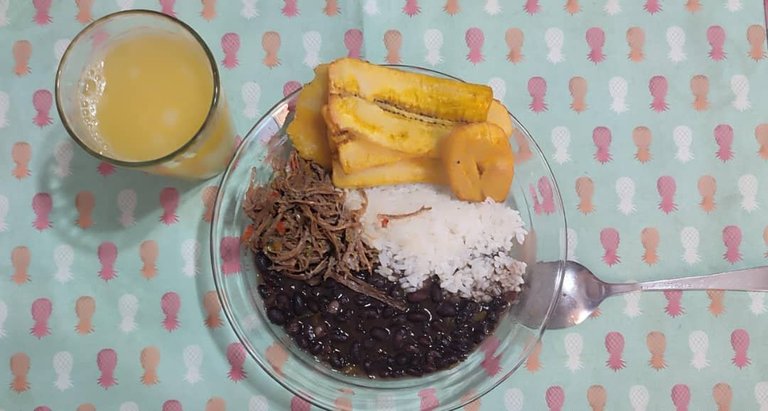Una nueva entrada al concurso semanal de topfamily en
Observa Piensa Escribe
A new entry to the weekly topfamily contest in
Observe Think Write

Exquisito Pabellón Criollo con carato o jugo de mango
El pabellón criollo es el plato icónico de Venezuela nuestra máxima presentación gastronómica, reconocido como nacional por excelencia, se dice que el pabellón se inició como comida para negros y esclavos , compuesto por carne mechada ( falda), arroz blanco, carota o frijol negro y tajadas de plátano maduro frito .
Su nombre se debe a la mezcla de colores de las tres razas que conforman nuestro pueblo (europea, indígena y africana), también por nuestro bandera de ahí se origina el nombre de pabellón, su origen es difícil de precisar puedo haber sido a finales del siglo XXI o principios del siglo XX, se dice que eran las sobras de las comidas de dos o tres días de anterioridad, dejada por los dueños de haciendas y reunidos por los esclavos, dónde lo único que se cocinaba el mismo día era el plátano frito.
El plato a variado con el transcurrir de los años y de acuerdo a la región donde se encontremos.
- El pabellón a caballo: se añade huevo frito y aguacate.
- Pabellón vegetariano: se sustituye la carne por tajadas de berenjenas fritas o guisado
- Pabellón oriental: en los estados orientales y Guayana es común añadirle azúcar a las caraotas mientras se cocinan.
- Pabellón alterado: en los llanos y en occidente del país,se cambia el arroz por pasta y se le agrega un huevo frito, queso rallado.
- El los Andes y el Zulia: tostones de plátano verde.
- En Lara: la carne es frita de chivo cabra .
- Pabellón mañanero, para desayunar: se sustituye el arroz por arepa asada, acompañado con queso rallado, aguacate, tajadas y caraotas.
Exquisite Criollo Pavilion with carato or mango juice
The Creole pavilion is the iconic dish of Venezuela, our highest gastronomic presentation, recognized as national par excellence. It is said that the pavilion began as a meal for blacks and slaves, composed of shredded meat (skirt), white rice, black beans and Fried ripe plantain slices.
Its name is due to the mixture of colors of the three races that make up our people (European, indigenous and African), also because of our flag, which is where the name pavilion originates. Its origin is difficult to specify, it may have been at the end of the 21st century or early 20th century, it is said that they were leftovers from meals two or three days earlier, left by the owners of haciendas and gathered by the slaves, where the only thing that was cooked the same day was the fried plantain. .
The dish has varied over the years and according to the region where we are located.
- The pavilion on horseback: fried egg and avocado are added.
- Vegetarian pavilion: meat is replaced with slices of fried or stewed eggplant
- Eastern pavilion: in the eastern states and Guyana it is common to add sugar to beans while they are cooked.
- Altered pavilion: in the plains and in the west of the country, rice is changed for pasta and a fried egg and grated cheese are added.
- The Andes and Zulia: green banana tostones.
- In Lara: the meat is fried goat goat.
- Morning pavilion, for breakfast: rice is replaced by roasted arepa, accompanied with grated cheese, avocado, slices and beans.
Lo cierto es que nuestro pabellón criollo además de ser un plato exquisito, equilibrado y balanceado, tiene una combinación perfecta de sabores, colores y texturas que nos hacen sentir orgullosos de ser venezolanos y de poseer ésa gama de sabores en nuestra mesa.
Buen provecho!
The truth is that our Creole pavilion, in addition to being an exquisite, balanced and balanced dish, has a perfect combination of flavors, colors and textures that make us feel proud to be Venezuelans and to have that range of flavors on our table.
Enjoy!
¡Gracias por leer!
Hasta una próxima oportunidad .
Thank you for reading!
Until next time.
La Versión en Inglés la realicé con el Traductor de Google.
The English version was made with Google Translate.